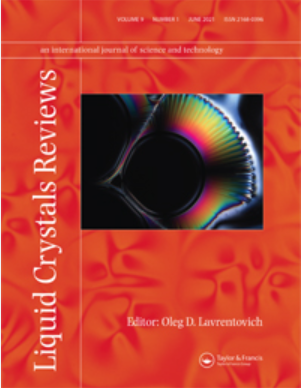液晶组装过程的性质
IF 4.2
3区 材料科学
Q2 CHEMISTRY, PHYSICAL
引用次数: 51
摘要
当某些分子溶解在溶剂(通常是水)中,这些分子自发地组装成各向异性结构时,就会形成慢性液晶。如果这些结构的密度足够高,温度足够低,它们就会组织成有取向的,有时也有位置顺序的液晶相。人们对慢性液晶的研究已经有半个多世纪了,但在过去的十年里,理论、计算和实验研究已经揭示了更多关于它们的细节。形成慢性液晶的分子结构变化很大,因此这些分子形成的组合也有很大的不同。最近的研究已经开始揭示这些组装过程,揭示出这些过程也可能在不同的系统之间有很大的不同。本文章由计算机程序翻译,如有差异,请以英文原文为准。
The nature of the assembly process in chromonic liquid crystals
Chromonic liquid crystals form when certain molecules are dissolved in a solvent, usually water, and the molecules spontaneously assemble into anisotropic structures. If the density of these structures is high enough and the temperature is low enough, they organize into a liquid crystal phase with orientational and sometimes with positional order also. Chromonic liquid crystals have been studied for more than half a century, yet theoretical, computational, and experimental investigations in the last decade have revealed many more details about them. The molecular structures that form chromonic liquid crystals are quite varied, and as a result the assemblies that these molecules form vary significantly also. Recent research has begun to shed light on these assembly processes, revealing that these too can be quite different from one system to another.
求助全文
通过发布文献求助,成功后即可免费获取论文全文。
去求助
来源期刊

Liquid Crystals Reviews
CHEMISTRY, PHYSICALCRYSTALLOGRAPHY&n-CRYSTALLOGRAPHY
CiteScore
7.60
自引率
5.90%
发文量
8
期刊介绍:
Liquid Crystals Reviews publishes review articles on all aspects of liquid crystal fundamentals and applied science, including experimental and theoretical studies of physical and chemical properties, molecular design and synthesis and engineering of liquid crystal devices. The Journal fosters cross-disciplinary exchange of ideas, encouraging authors to present material at a level accessible to specialists from other fields of science and engineering. Liquid Crystals Reviews provides the scientific community, in both academia and industry, with a publication of standing, guaranteed by the Editors and by the International Editorial Board who are active scientists in the worldwide liquid crystal community.
 求助内容:
求助内容: 应助结果提醒方式:
应助结果提醒方式:


